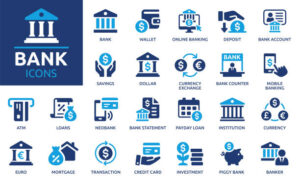Introduction
In today’s fast-paced digital era, Internet banking has emerged as a transformative force, revolutionizing the way we conduct financial transactions and manage our accounts. This article explores the concept of Internet banking, its evolution, benefits, security measures, popular features, and the future of digital banking. By delving into the details, we aim to provide a comprehensive understanding of this innovative banking approach.

Internet Banking
Understanding Internet Banking
Internet banking, also known as online banking or e-banking, refers to the ability to perform various banking activities and transactions over the internet. It enables customers to access and manage their accounts, transfer funds, pay bills, apply for loans, and perform other financial tasks conveniently, anytime and anywhere with an internet connection.
Evolution of Internet Banking
- Early Stages:
Internet banking traces its roots back to the 1980s when banks started experimenting with online systems to provide basic services like balance inquiries and fund transfers. However, these early systems were limited in functionality and accessibility.
- Advancements and Expansion:
With the proliferation of the internet in the 1990s, banks began investing in more sophisticated online platforms. This led to the introduction of user-friendly interfaces, expanded services, and enhanced security measures. Internet banking gained popularity as customers realized the convenience and time-saving benefits it offered.
- Mobile Banking and Apps:
The advent of smartphones and mobile applications in the 2000s further revolutionized internet banking. Banks developed dedicated mobile banking apps, providing users with seamless access to their accounts, notifications, and advanced features like mobile check deposits and person-to-person payments.
Also read on: Refinance car loan
Benefits of Internet Banking
Convenience and Accessibility
Internet banking eliminates the need for physical branch visits, allowing customers to manage their finances from the comfort of their homes or while on the go. With 24/7 availability, users can conduct transactions at their convenience, saving time and effort.
- Account Management
Internet banking provides users with real-time access to their account balances, transaction histories, and statements. It empowers customers to track their spending, monitor transactions, and gain better control over their financial health.
Fund Transfers
Internet banking facilitates swift and secure fund transfers between accounts within the same bank or to external accounts. Users can schedule recurring payments, make one-time transfers, and even set up automatic bill payments.
Online Bill Payment
With internet banking, customers can conveniently pay their bills online, eliminating the need for writing checks and mailing payments. Many banks offer bill payment features, allowing users to schedule payments in advance, receive electronic bills, and set up reminders.
Enhanced Security Measures
Internet banking employs robust security measures to protect users’ sensitive information and transactions. These measures include encryption, secure login protocols, multi-factor authentication, and real-time fraud detection systems.
Paperless Transactions
Internet banking promotes environmental sustainability by reducing the reliance on paper-based transactions. Users can opt for electronic statements, e-receipts, and digital communications, contributing to a greener banking experience.
Security Measures in Internet Banking:
Secure Login Procedures:
Banks implement strong authentication protocols, including usernames, passwords, and additional security measures such as security questions, one-time passwords (OTPs), or biometric authentication.
Encryption and Data Protection:
Internet banking platforms use encryption technology to protect data transmitted between the user’s device and the bank’s servers. This ensures that sensitive information remains confidential and secure from unauthorized access.
Fraud Detection and Monitoring
Banks employ advanced fraud detection systems that analyze user behavior, transaction patterns, and other indicators to identify and prevent fraudulent activities. Automated monitoring helps in timely detection and mitigation of potential risks.
Two-Factor Authentication (2FA)
To enhance security, banks often require customers to provide an additional authentication factor, such as a unique code sent via SMS or a mobile app, to verify their identity when conducting certain transactions or accessing sensitive information.
Security Education and Awareness
Banks educate their customers about online security best practices, such as creating strong passwords, avoiding phishing attempts, and regularly updating software and antivirus programs. They provide resources and guidelines to enhance customer awareness and vigilance.

Internet Banking
Popular Features of Internet Banking
Mobile Banking Apps
Mobile banking apps provide a seamless and user-friendly interface for accessing accounts, performing transactions, and managing finances. They often include additional features like budgeting tools, spending categorization, and account alerts.
Person-to-Person (P2P) Payments
Internet banking enables users to send money to friends, family, or businesses easily using P2P payment services. These services facilitate instant transfers between bank accounts, eliminating the need for cash or checks.
Mobile Check Deposits
Many banks offer the convenience of mobile check deposits. Users can simply capture an image of the check using their mobile devices and deposit it electronically into their accounts.
Card Management
Internet banking allows users to manage their debit or credit cards online. Features may include card activation, setting spending limits, reporting lost or stolen cards, and tracking transaction histories.
Account Alerts and Notifications
Users can set up customizable alerts and notifications to stay informed about their account activities, such as balance updates, transaction alerts, bill due reminders, and suspicious activity alerts.
The Future of Internet Banking
Artificial Intelligence (AI) and Chatbots
AI-powered chatbots are likely to become more prevalent in internet banking, providing customers with personalized assistance, answering queries, and helping with transactions and financial advice.
Enhanced Data Analytics
Banks will leverage advanced data analytics to gain valuable insights into customer behaviors and preferences. This will enable them to offer tailored financial products, targeted marketing, and personalized recommendations.
Open Banking
Open Banking initiatives are gaining momentum, allowing customers to securely share their financial data with authorized third-party providers. This facilitates enhanced financial management, personalized services, and integration with other platforms and applications.
Biometric Authentication
Biometric authentication methods, such as fingerprint scans, facial recognition, or iris scans, may become more widespread, providing enhanced security and convenience for users.
Conclusion
Internet banking has transformed the way we manage our finances, offering unparalleled convenience, accessibility, and a wide range of features and services. As technology continues to advance, internet banking will evolve further, incorporating innovations like AI, data analytics, and biometric authentication. With robust security measures in place, internet banking provides a secure and efficient means of conducting financial transactions, empowering individuals to take control of their financial lives with ease and confidence.
Frequently Asked Questions
What is internet banking?
Internet banking, also known as online banking or e-banking, refers to the ability to perform various banking activities and transactions over the internet. It allows customers to access and manage their accounts, transfer funds, pay bills, apply for loans, and perform other financial tasks conveniently, anytime and anywhere with an internet connection.
Is internet banking secure?
Yes, they employs robust security measures to protect users’ sensitive information and transactions. These measures include encryption, secure login protocols, multi-factor authentication, real-time fraud detection systems, and more. Banks invest heavily in security to ensure the safety of their customers’ data and funds.
What are the benefits of internet banking?
They offers several benefits, including convenience and accessibility, real-time access to account information, swift fund transfers, online bill payment options, enhanced security measures, paperless transactions, and the ability to manage finances on-the-go through mobile banking apps.
Can I trust internet banking for sensitive transactions?
Yes, they designed with security as a top priority. Banks employ encryption technology, secure login procedures, fraud detection systems, and customer education to ensure the security of sensitive transactions. However, it is essential to follow security best practices, such as using strong passwords, regularly updating software, and being vigilant against phishing attempts.
What features are typically available in internet banking?
Internet banking offers a range of features, including mobile banking apps, person-to-person payments, mobile check deposits, card management, account alerts and notifications, and access to account statements and transaction histories. The specific features may vary between banks.
How can I enroll in internet banking?
To enroll in internet banking, you typically need to visit your bank’s website or mobile app and follow the instructions to create an online banking account. This may involve providing personal and account information, creating login credentials, and setting up security measures. Some banks may require customers to visit a branch in person to complete the enrollment process.
Can I access internet banking from multiple devices?
Yes, internet banking can be accessed from multiple devices, including personal computers, laptops, smartphones, and tablets. Banks provide compatibility and user-friendly interfaces across various devices, allowing customers to access their accounts seamlessly.
Can I perform all banking transactions online?
Internet banking offers a wide range of banking transactions, including fund transfers, bill payments, account management, loan applications, and more. However, certain transactions, such as cash deposits or complex financial services, may still require visiting a physical bank branch.
How can I ensure the security of my internet banking activities?
To ensure the security of your internet banking activities, it is important to follow security best practices. This includes using strong and unique passwords, keeping your login credentials confidential, regularly updating software and antivirus programs, being cautious of phishing attempts, and avoiding accessing your accounts on public or unsecured networks. Banks also provide security guidelines and educate customers on best practices to protect their online banking activities.

Leave a Comment